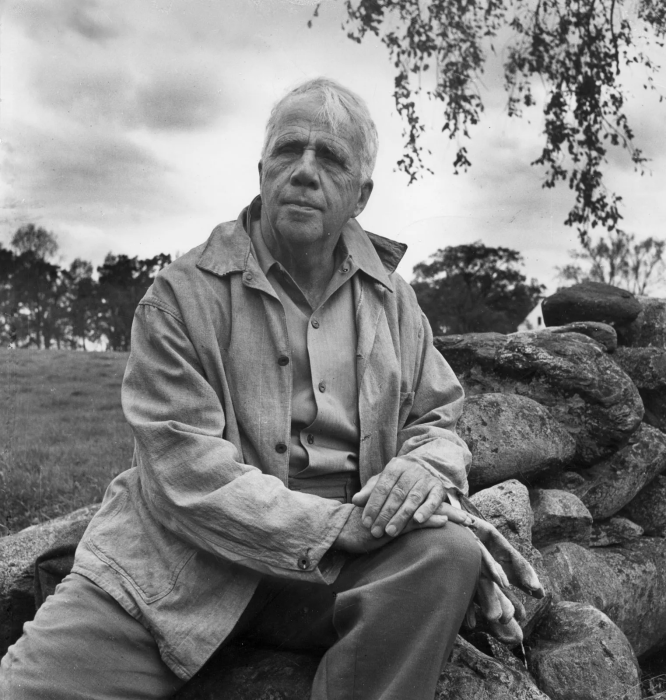
Dust of Snow By Robert Frost
_Robert Frost
Summary
|
It is winter season and the poet is in a bad mood sitting quietly under the hemlock tree covered all the snow. On spur of the moment, a crow sitting on the branch of a tree shakes the tree, and the snow from the tree falls on the poet. The snow is cold and velvety to the touch which changes the poet’s mood from bitter to elate. This fills him with a refreshing feeling. This moment was very compelling and saves his day from disappointment. The black crow usually symbolizes a bad omen and emblem of death and fear. Since the crow is not related to goodwill, it is ironic that during this poem he did an honest deed by shaking off the snow. Robert Frost did not prefer to use any other trees like oak, maple, or pine. He chose the hemlock which is typically related to poison and toxicity. Similarly, he uses dust which is useless to anybody and nobody wants to be like dust. But the poet uses it as an impulse that brings positive thoughts to mind. Anyway, the alluring snow that adorns the poisonous hemlock tree’s branches is shaken off by a scarecrow. We have toxic hemlock covered in pure, white snow, and a person who is depressed, getting to kill himself and walking under the tree. The black crow throws the snow on the poet. The feel of pure cold snow alters his mind about sacrificing his life. On the contrary, he decides to forget the regrets of his life and sorrow to follow the path of healing the inner soul. |
Q.1. What is a “dust of snow”? What does the poet say has changed his mood? How has the poet’s mood changed?
Ans: The ‘dust of snow’ means the fine particles or flakes of snow. The sudden shower in the form of the dust of snow changed the poet’s mood. The poet’s attitude changed from sad to happy. He felt refreshed and wanted to enjoy the rest of the day.
Q. 2. How does Frost present nature in this poem?
The following questions may help you to think of an answer.
What are the birds that are usually named in poems?
Do you think the crow is often mentioned in poems?
What images come to your mind when you think of a crow?
Again, what is ‘a hemlock tree’?
Why doesn’t the poet write about more ‘beautiful’ trees such as a maple, or an oak, or a pine?
What do the ‘crow’ and ‘hemlock’ represent-joy or sorrow?
What does the dust of snow that the crow shakes off a hemlock tree stand for?
Ans. Frost presents nature in a very different manner in the poem,
Generally, poets take the birds and trees which are known for their beauty and good qualities like peacocks, parrots, cuckoos, mynah, and trees full of beautiful flowers and fruits, etc. But here Frost has taken a totally different approach. He chose a crow, which is not often used in poems. Crow is black in color with a very harsh voice and is believed to be a symbol of a bad omen. Thinking of a crow brings very depressing and sorrowful pictures to our minds.
A hemlock tree is a poisonous plant with small white flowers. The poet, Robert Frost, didn’t choose to use an oak, maple, or pine tree. Instead, he chose the hemlock tree and left all the beautiful trees present in the world. Actually, he did so to present his mood and feelings.
The crow and hemlock tree represent the sorrow and depression felt by the poet in this materialistic world. The dust of snow is the symbol of natural joy and energy. The dust of snow that the crow shakes off a hemlock tree means passing through the sad and depressing moments the poet is entering into a time full of joy and optimism.
Q.3. Have there been times when you felt depressed or hopeless? Have you experienced a similar moment that changed your mood that day?
Ans: There have been innumerable times when I too have felt depressed and hopeless. Sometimes, such moments were aroused by other people’s behavior and attitude and sometimes due to my own conduct. On one occasion when I was very upset. I went out for a walk. While walking in the park, I saw a girl playing with a puppy, embracing and feeding him. This little joy that they shared changed my mood and I felt very happy for the rest of the day. I also joined the two and played with them.
Extra Questions: –
1. What does the poet want to convey through the poem “Dust of Snow”?
Ans: In the poem “Dust of Snow” the poet wants to convey that sometimes certain moments are actions that are simple and have longer significance. They can change the mood or life of a person. The way the crow shakes down the dust of snow on the poet inspires and gives him the idea to shake off his depressive thoughts, become cheerful and do something useful.
2. Our attitude towards a situation evokes both negative and positive responses. Analyze this with the poem “Dust of Snow”.
Ans: Whatever situation life throws at us, it evokes both positive and negative responses. The post in the poem “Dust of Snow”, was in a sorrowful mood. However, when a crow shook down the dust of snow on him, his bitter mood changed into a more optimistic one. Now being in a sorrowful or bad mood already, the poet could have got angry with the crow also. However, snow dust becomes a positive medium of change for him. It made him cheerful to some extent and helped him forget his sadness, at least for a few moments. Thus, we see that instead of seeing the negative aspect, one should see the positive aspect, and one’s response may greatly affect the outcome of the incident.
3. Small things in life make significant changes in one’s life. Elaborate this with the reference “Dust of Snow”.
Ans: The poem “Dust of Snow” reiterates that the little things in life can make huge changes in our future. It also shows that if we can face the hardships of life in stride, eventually something will happen to change our situation into happier times.
The simple things that we do for others can make all the difference. Just as random acts of kindness, we do how they brighten a person’s day and sometimes change their future. Appreciating all the small things in life will make our life much easier and happier. It will also cause us to have a spirit that is willing to change and therefore succeed.

